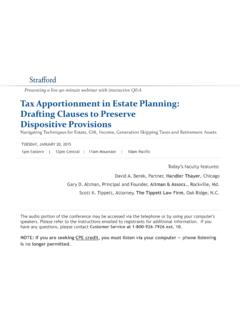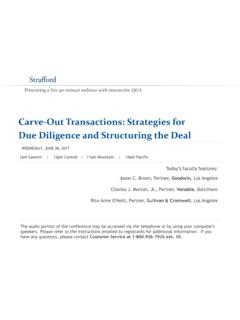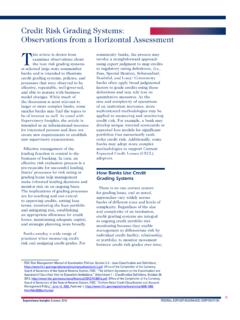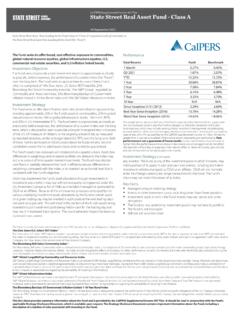Transcription of Allocating Operating Expenses in Commercial Real Estate ...
1 The audio portion of the conference may be accessed via the telephone or by using your computer's speakers. Please refer to the instructions emailed to registrants for additional information. If you have any questions, please contact Customer Service at 1-800-926-7926 ext. 10. Presenting a live 90-minute webinar with interactive Q&A Allocating Operating Expenses in Commercial real Estate Leases: Negotiating Strategies for Landlords and Tenants Structuring Pass-Throughs, Exclusions, Gross-Up, Expense Cap and Other Operating Expense Provisions in Net and Gross Leases Today s faculty features: 1pm Eastern | 12pm Central | 11am Mountain | 10am Pacific TUESDAY, NOVEMBER 14, 2017 Scott D.
2 Brooks, Partner, Cox Castle & Nicholson, San Francisco Robert J. Sykes, Partner, Cox Castle & Nicholson, Irvine, Calif. Tips for Optimal Quality Sound Quality If you are listening via your computer speakers, please note that the quality of your sound will vary depending on the speed and quality of your internet connection. If the sound quality is not satisfactory, you may listen via the phone: dial 1-866-873-1442 and enter your PIN when prompted. Otherwise, please send us a chat or e-mail immediately so we can address the problem. If you dialed in and have any difficulties during the call, press *0 for assistance. Viewing Quality To maximize your screen, press the F11 key on your keyboard.
3 To exit full screen, press the F11 key again. FOR LIVE EVENT ONLY Continuing Education Credits In order for us to process your continuing education credit, you must confirm your participation in this webinar by completing and submitting the Attendance Affirmation/Evaluation after the webinar. A link to the Attendance Affirmation/Evaluation will be in the thank you email that you will receive immediately following the program. For additional information about continuing education, call us at 1-800-926-7926 ext. 35. FOR LIVE EVENT ONLY Program Materials If you have not printed the conference materials for this program, please complete the following steps: Click on the ^ symbol next to Conference Materials in the middle of the left-hand column on your screen.
4 Click on the tab labeled Handouts that appears, and there you will see a PDF of the slides for today's program. Double click on the PDF and a separate page will open. Print the slides by clicking on the printer icon. FOR LIVE EVENT ONLY Allocating Operating Expenses IN Commercial real Estate LEASES: NEGOTIATING STRATEGIES FOR LANDLORDS AND TENANTS STRAFFORD PUBLICATIONS November 14, 2017 Scott D. Brooks, Esq. Cox, Castle & Nicholson LLP 50 California Street, Suite 3200 San Francisco, California 94111 Phone: (415) 215-4962 Email: Robert J. Sykes, Esq. Cox, Castle & Nicholson LLP 3121 Michelson Drive, Suite 200 Irvine, California 92612 Phone: (949) 260-4640 Email: OUTLINE OF PRESENTATION I.
5 Different Types of Lease Structures A. Net Leases 1. Typical in retail and industrial; less common in office. 2. In single tenant context, may allocate responsibility for work to Tenant, at Tenant s cost. B. Base Year (or Full Service Gross) Leases 1. Typical in office leasing and sometimes in industrial. 2. Base Year is typically the first calendar year where there is 6 months after Commencement Date (so June 30 Commencement Date is typical cut off to move to next calendar year for Base Year). 3. Use of different categories to lessen impact of cost spikes in taxes, utilities or insurance costs. 4. Expense stop leases (using fixed amount as base rather than actual costs for a particular year).
6 C. Gross Leases 1. Mostly used in short term leases/licenses. D. Hybrid ( , Net for Electricity or Janitorial) 1. Utility cost spikes have resulted in some landlords taking electrical costs out of Base Year. E. Fixed Contributions 1. Increasingly common in regional malls and mixed use projects to simplify cost allocations/disputes. 6 II. Standard Operating Expenses Inclusions and Exclusions A. Included Items 1. General: costs of operation, management, ownership, maintenance and repair of the Project, as determined by accepted principles of sound accounting practice. 2. Utility costs and costs of janitorial, security and other services. 3.
7 Insurance costs and deductibles. 4. Project management, including management personnel costs, management office rental and management fees. 5. Costs of repairs, maintenance and replacements, including costs of supplies, materials, equipment and tools required therefor. B. Excluded Items 1. Capital expenditures a. Complete exclusion b. Limited inclusion with amortization of costs. 7 2. Ground lease rent and mortgage related costs. 3. Costs reimbursed by insurance, warranties or other third parties. 4. Costs of build out of tenant spaces and leasing costs, including marketing, attorneys fees and broker commissions. 5. Depreciation or amortization (but see capital Expenses ).
8 6. Expenses in connection with services or amenities not available to Tenant or for which Tenant is separately charged. 7. Amounts paid to Landlord affiliates in excess of market rate for goods or services. 8. Landlord s overhead or administrative costs, such as personnel costs above the level of Building manager. 9. Costs relating to hazardous materials. 10. Costs of charitable or political contributions. 11. Costs of relating to artwork (other than ordinary maintenance). 12. Costs of correction of pre-existing non-compliance with applicable laws. 13. Costs of sale, refinancing of all or any part of the Project or any interest in Landlord.
9 14. Increases in tax Expenses resulting from a change in ownership. 15. Taxes on rent or income of Landlord. 8 16. Interest on late payment (other than interest on Tax Costs paid in the maximum number of permitted installments with interest). 17. Parking facility costs or costs of any other Commercial operation at the Project. III. Gross-Up Provisions A. Grossing up the components of Operating Expenses that vary based on occupancy B. Grossing up the cost of items separately provided by one or more tenants in lieu of being provided by Landlord C. Cost pooling D. Treatment of new categories of Expenses IV. Expense Cap Provisions V. Audit Rights 9 SAMPLE NEGOTIATED Operating EXPENSE LEASE PROVISION ( REDLINED TO SHOW CHANGES FROM LANDLORD S INITIAL DRAFT) 6.
10 Operating AND TAX Expenses . A. For the purposes of this Section 6, the following terms are defined as follows: 1. Tenant s Percentage shall be that percentage set forth in Section 1(i), which percentage is the quotient of the Rentable Area of the Premises divided by the Rentable Area of the Project, and which percentage shall be subject to adjustment in the event of reduction or increase in the Rentable Area within the Premises and/or Project. 2. Base Year Operating Expenses shall mean the Operating Expenses (as hereinafter defined) incurred in the Base Year. 3. Base Year Tax Expenses shall mean the Tax Expenses (as hereinafter defined) incurred in the Base Year.


















